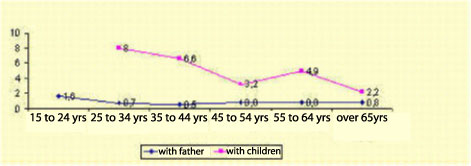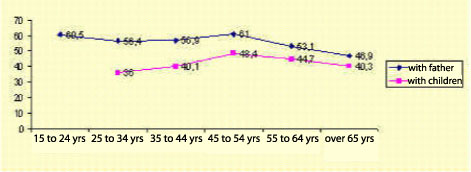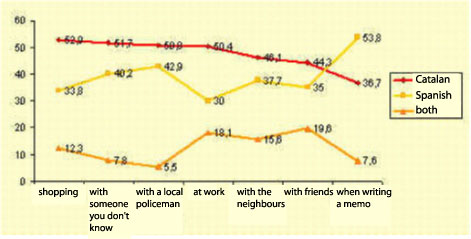 |
Finally,
we can see the same phenomenon, intersected with the variable of age, in figures 5, 6 and
7. Figure 5.
Individuals who speak Catalan with their father and their children, by age. 1997.
Percentages

Source: DYM 97.
Own work
Figure
6. Individuals who speak both languages with their father and their children, by age.
1997. Percentages
 Figure
7. Individuals who speak Spanish with their father and their children, by age. 1997.
Percentages
Figure
7. Individuals who speak Spanish with their father and their children, by age. 1997.
Percentages

Source: DYM
97. Own work.
Let us take a
closer look at these diagrams.
Firstly, if we
look at the language spoken with the father, it is clear that Spanish is stronger in the
younger and intermediate age ranges, whereas Catalan is only a majority among individuals
aged 65 or over. The highest points are for those aged 45 to 54 and 15 to 24, an
absolutely undeniable generational fact.
Secondly, in the
case of the language spoken with their children, this result is reversed in all the ranges
we analysed, except in the abovementioned 45 to 54 year range: the majority group consists
of individuals who speak to their children in Catalan, with a declining tendency to use
Spanish, albeit reinforced by an increase in the bilingual option. We will need to wait
five or ten years to find out what will happen with the individuals now aged between 15
and 24, who are still almost all without children and thus can not be taken into account
in these figures. Remember that these are the children of the age range with the least
domestic use of Catalan. If the result were that Catalan had been maintained with figures
of 55% or over, we could now say that we have overcome a significant stumbling block and
that the option of linguistic integration is now heading towards consolidation. Otherwise,
we will need to wait for longer and see what happens with further generations.
Finally, we need
to focus on how the two lines draw closer or further apart with the passing of time. Here,
on the contrary, the trend is clearly positive, and increases as we move from oldest to
youngest. The age range that we considered the most "difficult" is precisely
that marking the turning-point:. Thus, we increase from a difference of 4.6 points in
favour of those who speak Catalan with their children in the 55 and 64 age range, to one
of 11 points in the preceding age group.
3. "Non-domestic" uses
3. 1. Use in a range of situations
We will begin with
Figure 8.
Figure 8.
Linguistic use in a range of situations. 2000. Percentages
 |
